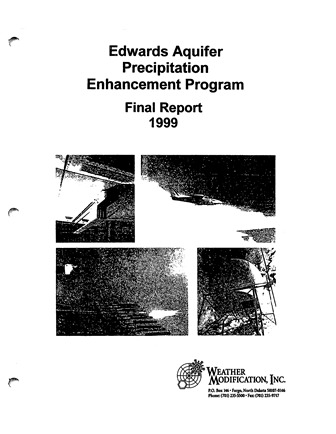Edwards Aquifer Precipitation Enhancement Program Final Report 1999

| Summary |
|
This report summarizes the activities and data collected during the 1999 field operations of the Edwards Aquifer Precipitation Enhancement Program. This was the first year of a projected long-range program conducted by Weather Modification Inc. (WMI) of Fargo, North Dakota, for the Edwards Aquifer Authority (the Authority) of San Antonio, Texas. The program is funded partially by money from the Texas Natural Resource Conservation Commission, with the sole intent to enhance precipitation through cloud seeding. The project area was 5.44 million acres across south Texas, covering all or parts of 12 counties including Real, Uvalde, Kerr, Bandera, Medina, Kendall, Bexar, Blanco, Comal, Hays, Guadalupe, and Caldwell. A 24 hours per day, seven days per week cloud seeding service was provided from April 15th through September 15th. The facilities and procedures for facilitating this project were as follows. One Cband weather radar, computers, and a communications system were set up in Hondo, Texas, for storm monitoring and aircraft control purposes. The radar operated continuously throughout the five-month period. Radar pictures were available and posted on the WMI Internet Home Page at 30-minute intervals, thus allowing remote viewing of operations. Two specially equipped cloud seeding aircraft were dedicated to the project. Both aircraft were stationed at the Hondo Regional Airport in Hondo, Texas, to provide adequate coverage of the target area and minimum response time to potential seeding candidates. New and improved formulations of silver-iodide pyrotechnics and acetone solutions were used to generate high concentrations of very fast acting ice nuclei. High performance aircraft with experienced pilots and radar meteorologists provided fast response and the direct injection of the seeding material into the developing regions of the storms. The 1999 field program successfully achieved its objective, to seed cell with the potential to produce precipitation. During the 5-month project, the two aircraft completed 65 missions totaling 174.9 flight hours and dispersed 37.5 kg of silver iodide. The 37.5 kg of silver iodide comes from a total of 1,826 ejectable flares and 15 gallons of silver iodide- acetone solution from wing-tip generators used during the project. The year can best be characterized as one with many low intensity thunderstorms and a few of days with very severe, long-lived, high intensity storms. Concerns voiced during the project period were that there were clouds overhead and the planes were not. During much of the summer a strong high-pressure cell was located over the southern High Plains. Although there were numerous cumulus type clouds on most days, they were of the fair weather variety and had no potential to produce precipitation. Cloud modification cannot initiate the convective process but can aid it once convection begins. During each occasion with the potential for rainfall enhancement, seeding aircraft were dispatched to those areas within the target area. This final report for 1999 provides a general overview of the program describing the methodology used. Pictures, tables, graphs, and references are used to summarize the operational activities. All of the project’s radar data, meteorological data, and reports have been recorded onto CD-ROM and are available to the Authority. |
Search for Documents
Advance Search
Explore EAA's Scientific Reports
- All Reports
- Springs, Groundwater Discharge
- Archaeology
- RZ Protection
- Aquifer Levels
- Remote Sensing
- Precipitation
- Overview Studies
- Modeling
- Hydrology and Hydrogeology
- History
- Groundwater Recharge, Recharge Zone
- Groundwater Movement
- Geomorphology and Caves
- Weather Modification
- Geology
- Water Use and Conservation
- Geochemistry
- Water Resources Planning and Management
- Floods and Drought
- Water Quality
- Climatology
- Surface Water / Groundwater Relationship
- Biology
